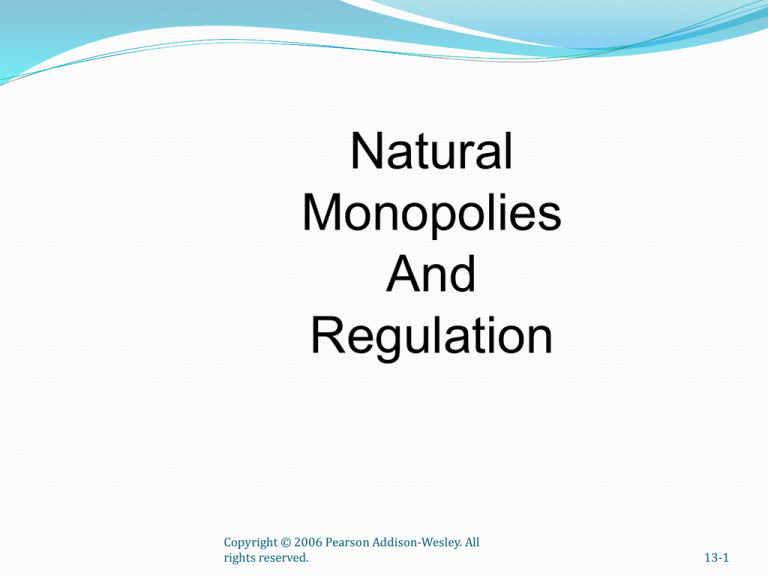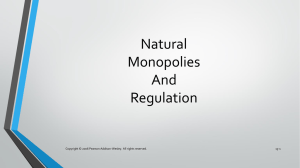
Natural
Monopolies
And
Regulation
Copyright © 2006 Pearson Addison-Wesley. All
rights reserved.
13-1
Natural Monopolies
Economies of Scale continue to occur at so large a scale
that is it is “productively efficient” (least cost) to have
only 1 provider
Natural state and optimal state is a monopoly
typically high fixed costs and low variable costs
electric, natural gas, water, telecommunications (land)
and tv cable
Copyright © 2006 Pearson Addison-Wesley. All
rights reserved.
13-2
Regulation
If a natural monopoly arises due to scale economies,
the government may prefer to regulate the monopoly.
Breaking the firm up may reduce efficiency
Copyright © 2006 Pearson Addison-Wesley. All
rights reserved.
13-3
Figure 13.2 Natural Monopoly in the
Telecommunications Industry
Copyright © 2006 Pearson Addison-Wesley. All
rights reserved.
13-4
Government Regulation of
Price and Output
The government cannot require that a natural
monopolist set price equal to marginal cost.
Because marginal cost is less than average
cost, two options:
1. Government subsidizes the loss (Euro approach)
No deadweight loss, but requires taxes on other goods
2. Average Cost Pricing (or Rate of Return (ROR)):
government sets price equal to average total cost. (US
solution)
Leads to some deadweight loss, but less than a monopoly
Copyright © 2006 Pearson Addison-Wesley. All
rights reserved.
13-5
Figure 13.3 Choosing a Price for a Natural
Monopolist
US
French
Economic Loss
or Subsidy
Copyright © 2006 Pearson Addison-Wesley. All
rights reserved.
13-6
Government Regulation of Price
and Output
Two methods of regulating price and output:
Rate of Return Regulation—the firm is allowed to earn
a pre-specified amount of profit in a given time period.
Set prices to recover average cost + normal rate of return
How do you determine normal ROR?
Incentive for regulated firm to “pad” its costs (Averech-Johnson
effect)
Price Cap—government sets the maximum price or the
maximum rate of price increase.
After rate setting process: future rates can be raised by rate of
inflation Copyright
– industry’s
average productivity (incentive for tech.
© 2006 Pearson Addison-Wesley. All
13-7
iinnov.) rights reserved.
Deregulation
The current trend is for the government to remove
regulation and allow
market forces to determine prices, output, profits, and
industry structure.
Factors favoring deregulation:
Difficulty in determining a regulatory strategy
Advances in technology that have lead
to increased competition
Copyright © 2006 Pearson Addison-Wesley. All
rights reserved.
13-8
Reasons For Deregulation
In deciding to deregulate an industry,
the government must be confident that private
market outcomes will be more efficient than
regulated outcomes.
Will deregulation affect product safety or reliability?
Will deregulation eliminate service for
some customers?
Will the benefits of deregulation accrue to only a few
customers?
Copyright © 2006 Pearson Addison-Wesley. All
rights reserved.
13-9
Application:
Deregulation of the Airline Industry
In 1978, the U.S. Airline Deregulation Act removed
regulations on prices, the number of carriers and
route assignments.
(some) Passengers have benefited from the resulting
price competition among air carriers.
FAA set similar rates for flights of similar difference, regardless
of destination (and demand in large/small cities)
“legacy” losses and gains
Smaller cities saw higher prices and fewer flight
Larger cities: lower prices, more flights
Copyright © 2006 Pearson Addison-Wesley. All
rights reserved.
13-10
Application:
Deregulation of theTelecommunications
In 1980, AT&T and the “Baby Bells” were broken
up into 8 different companies
AT&T could offer only long distance service and had to
compete with MCI and Sprint (no longer a monopoly)
Baby Bells’ customer could choose their LD provider
Took several years for AT&T market share to drop below 80%
Colbert video – “it’s all back together again”
FCC missed that there were economies of scale – led to
mergers to reduce costs
1996 Congress passed the Telecommunications Act
Copyright © 2006 Pearson Addison-Wesley. All
rights reserved.
13-11
Application:
Deregulation of theTelecommunications
1996 Congress passed the Telecommunications Act
Required Baby Bells and GTE to open their local markets
to all competitors
Established prices that Bells could charge competitors for
“renting” their lines and switching equipment
Prices were set below incurred (or historical) costs
Decreased incentive to maintain and update existing
equipment
Previously business line rates set higher than costs to
subsidize residential phone service
New entrants targeted business customers and high long
distance usage customers (winners)
Copyright © 2006 Pearson Addison-Wesley. All
rights reserved.
13-12
Strategy and Policy
The Department of Justice takes on Cingular–AT&T
Wireless merger
In 2004, Cingular agree to buy AT&T Wireless, creating a
company with an HHI of 8,000 in some markets.
In 2005, the firm was required to divest the entire AT&T
Wireless network in the 13 markets where
concentration was highest.
Copyright © 2006 Pearson Addison-Wesley. All
rights reserved.
13-13








